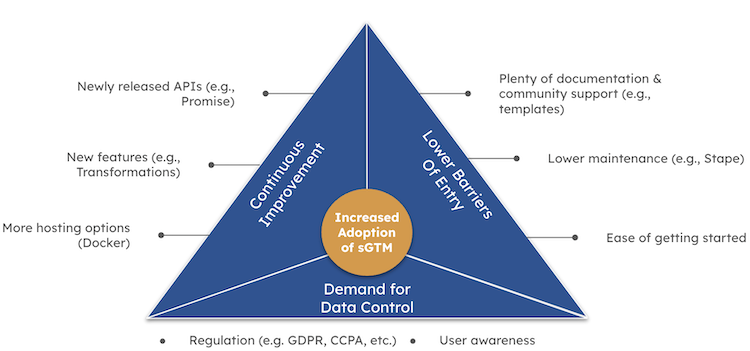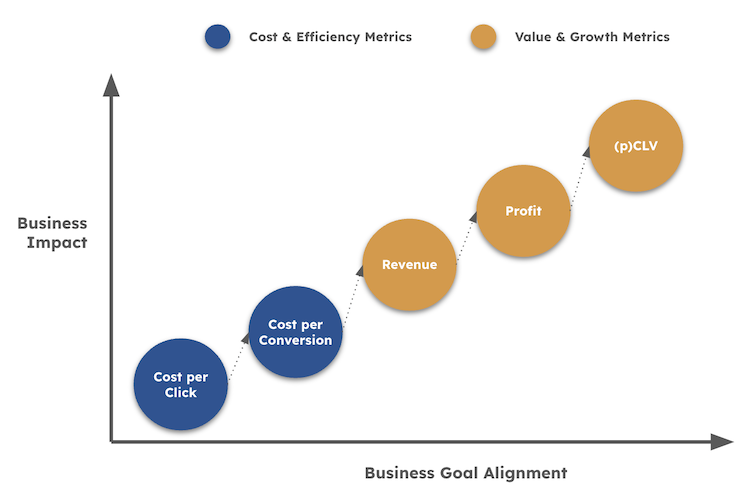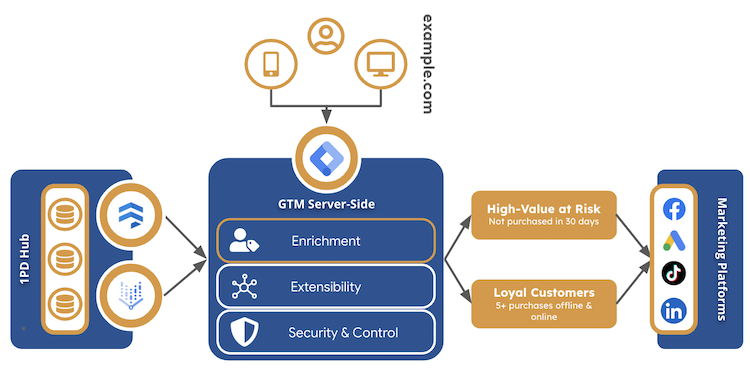“What are your main use cases for GTM Server-Side?” I repeatedly ask this question (or a variation of it) when entering engagements with clients whose analytics and/or marketing departments have previously adopted GTM Server-Side (sGTM).
Most often, though, the answers to this question could be more compelling. They tend to range from “We simply want to collect more data by bypassing ad blockers and browsers’ tracking prevention “ to “We want to make our measurement setup more compliant.” to “We don’t have a use case, but everybody else seems to be doing it—so, we did as well.”
Disclaimer: While integrating sGTM into your measurement stack can benefit if done right, not every company necessarily has to adopt sGTM.
Unlocking GTM Server-Side’s potential
Don’t get me wrong—the above answers—well, at least the first two—make sense from a business perspective. Investing in your setup’s compliance is insurance that helps prevent more considerable harm due to potential fines should your setup ever come under scrutiny by the respective authorities. So, it is a wise business decision to hedge your risks here.
Having more data about your users and a better understanding of their actions, where your website’s user experience doesn’t live up to expectations, etc., can help you optimize your online presence. Signaling more conversion events back to your marketing vendors’ platforms will likely positively affect your marketing performance, result in cost savings, or even help contribute more revenue. Again, a decision maker in digital marketing in this age of hard-to-get marketing budgets is wise to seize this opportunity (if the company’s legal department and one’s own ethics allow for it).
But still, having these measures in place is no longer a competitive advantage as we see entry barriers being lowered to deploy these technical solutions (there are tons of templates and solution guides out there), and the associated costs with maintaining these solutions are going down as well (you can run a sGTM for 20 bucks/month or less these days). The trend is clear: the adoption rate of sGTM in companies will keep increasing, and your business’ competitive advantage will shrink.
 GTM Server-Side Adoption Drivers
GTM Server-Side Adoption Drivers
To say it more bluntly, if you and your team have decided to pursue the sGTM route, having the above in place should be simply the first step of a longer journey during which you’ll reap the benefits of your efforts.
From implementation to innovation
The real cost isn’t in choosing between client-side and server-side implementations; it’s in not fully utilizing the server-side capabilities you’ve already deployed. Companies with mature server-side implementations are seeing:
- Improved marketing budget efficiency through real-time value-based bidding
- AI-powered personalization driving measurable increases in customer engagement
- Enhanced audience targeting through secure integration of first-party data
Consider this: Your server-side infrastructure is already in place. The marginal cost of implementing advanced use cases is probably minimal compared to your initial investment, yet the potential returns are substantial. While basic server-side tagging is becoming commonplace, sophisticated implementations that truly leverage its capabilities remain a differentiator.
Throughout this process of climbing up the majurity curve, I recommend coming back to the below question every now and then:
“Are we leaving money lying on the floor by not acting fast enough on the data we’re already collecting?”
What is GTM Server-Side?
Think of GTM Server-Side as your company’s digital command center for data. In the traditional, client-side-only setup, your website directly sends data to various marketing and analytics platforms - think Google Analytics, Facebook, LinkedIn, and others. It’s like having multiple direct phone lines from your website to each service. GTM Server-Side changes this dynamic entirely. Instead of these direct connections, you now have a central hub - your own digital measurement headquarters - where all information flows through first. It’s like having a reception desk that handles all incoming and outgoing communications.
 GTM Server-Side High-Level Architecture
GTM Server-Side High-Level Architecture
Why does this matter for your business?
- You’re less dependent on browser restrictions and ad blockers
- You can enforce data sharing restrictions in line with privacy regulations
- You gain control over what data leaves your domain
- You can enhance the data before sending it out
But here’s where most businesses stop short: They see GTM Server-Side merely as a way to collect more data or as a compliance tool. That’s like buying a sophisticated smartphone and using it only for calls and texts. What you can do with this central data hub is the real power.
Think of it this way: You’re not just creating a more secure pipeline for your data; you’re building a transformation station where raw data can be turned into actionable business intelligence before it reaches its final destination. This is where the real competitive advantage begins—not in the collection of data, which is becoming increasingly a commodity, but in how intelligently you can process and utilize it.
GTM Server-Side use cases that drive business value
Now that we have a shared understanding of GTM Server-Side, let’s explore how it can be leveraged beyond collecting more data. The real magic happens when we start thinking of sGTM not just as a data collection tool but as an integration hub that can blend different data streams and sources in real-time.
One of sGTM’s most powerful capabilities is its ability to integrate first-party data from various sources into users’ clickstream data. “But wait,” you might say, “haven’t we always been able to integrate offline data through batch uploads?” Yes, you’re right—but there’s a crucial difference. Traditional batch uploads are exactly what they sound like: batched and often delayed. They’re like sending a weekly report instead of having a real-time dashboard.
With GTM Server-Side, instead of waiting for nightly batch processes to sync your valuable business data, you can now enrich your data streams in real time and at the event level. This means your marketing platforms’ algorithms can start optimizing toward actual business outcomes immediately rather than waiting for the next day’s data upload, which can significantly improve your campaigns’ performances and ROI.
Let’s explore some concrete use cases that showcase how this real-time data integration capability can create tangible business value.
Bidding closer to actual business goals
Looking at the evolution of digital marketing optimization with tightening budgets, there’s a clear progression from basic efficiency metrics towards more impactful business outcomes. While most marketers start with optimizing cost per click and move on to cost per conversion, the real business impact lies further up the chain - in revenue, profit, and, ultimately, customer lifetime value optimization.
 Overview of traditional optimization metrics
Overview of traditional optimization metrics
Here’s where GTM Server-Side reveals one of its most powerful capabilities: enabling real-time value-based bidding with actual business metrics while keeping sensitive data private. Wouldn’t you rather have your marketing platforms optimized for actual profit instead of just revenue? Or even better, towards predicted customer lifetime value? “But wait,” you might say, “couldn’t we just send this data directly to our advertising platforms?” Well, yes and no.
Here’s the dilemma (or trilemma) many businesses face:
- Send sensitive profit or predictive data directly through the browser, risking exposure to determined users
- Use proxy values instead of actual profits, compromising optimization potential
- Upload data in batches through APIs, losing real-time optimization capabilities
GTM Server-Side elegantly solves this trilemma. It acts as a secure middleware where you can:
- Pull in sensitive profit data in real-time
- Transform it before sending it to marketing platforms
- Keep it hidden from end users
- Maintain real-time bidding capabilities
This means you can finally move your optimization efforts higher up the value chain - from simple cost metrics to actual business outcomes - without compromising on security or real-time capabilities. Your advertising platforms can now optimize towards real profit or lifetime value, not just revenue or conversion counts.
Create rich audiences
While optimizing toward business outcomes is powerful, there’s another dimension where GTM Server-Side shines: creating sophisticated audience segments based on your first-party data. Think beyond simple website behavior - what if you could combine your users’ online actions with their complete customer history?
“But we already segment our audiences,” I often hear. Yes, but let’s be honest—most businesses are barely scratching the surface of what’s possible. They’re like a retail store that only remembers what customers did during their current visit, completely ignoring their rich purchase history from previous visits.
 GTM Server-Side powered Audience Segmentation
GTM Server-Side powered Audience Segmentation
Here’s where sGTM becomes your powerful ally. Instead of relying solely on current session data, you can now:
- Identify returning customers even when they use guest checkout
- Factor in offline purchase history in real-time
- Include customer segmentation data from your CRM
- Leverage predictive metrics like churn probability
- Apply custom business rules without exposing them to the browser
The best part? Again, all of this happens in real time without exposing sensitive customer data in your website’s code. It’s like having a personal assistant who knows your customers’ complete history but only shares relevant information with those who need it.
Let’s make this concrete: Imagine creating an audience of “high-value customers who haven’t purchased in the last 30 days and have a high churn probability.” Traditional setups require complex data pipelines and likely expose sensitive business rules in your website’s code. With GTM Server-Side, this becomes a secure, real-time operation that keeps your business logic private while enabling sophisticated marketing automation.
Real-time personalization with AI
In this day and age, when AI is all the rage in digital marketing, I know that you’ve been waiting for some inspiration on how to use it in the context of GTM Server-Side.
So, imagine combining your rich first-party data with the power of generative AI—all in real time and without exposing sensitive customer information.
Most businesses either shy away from AI implementation due to technical complexity or end up with clunky, delayed solutions that feel more like science experiments than business tools.
GTM Server-Side attempts to change this narrative. By integrating with AI services like Google’s Gemini, you can:
- Generate personalized product recommendations based on complete customer history
- Create dynamic, context-aware marketing messages
- Adapt website content in real-time based on customer segments
- Automate sophisticated customer interactions
- All while keeping your customer data secure and private
Think of it this way: instead of showing all returning customers the same generic “Welcome back!” message, you could generate truly personalized greetings like “Welcome back, Sarah! We noticed you loved our sustainable collection last time—we’ve just launched new eco-friendly items we think you’ll love.” The best part? This happens in real time, using your secure customer data that never leaves your control.
This isn’t just about creating clever messages - it’s about scaling personalization in a previously impossible (or too expensive) way. Your marketing can now adapt quickly to customer behavior, preferences, and history, creating truly personal experiences while maintaining enterprise-level security and privacy - all powered by sGTM.
Conclusion
Consider the above use cases presented here mere starting points for your journey. Your competitive advantage lies in combining GTM Server-Side’s capabilities with your unique business understanding and creativity.
As privacy regulations tighten and third-party data becomes scarcer, intelligent first-party data activation becomes more relevant. If you’ve implemented GTM Server-Side, use it as a foundation to:
- Transform raw data into real-time insights
- Build privacy-compliant marketing automation
- Create personalized customer experiences
- Maintain control over sensitive data
The question isn’t whether you need GTM Server-Side, but how you’ll use it to create value for your business. While implementation is becoming more accessible, success lies in combining the technology with your team’s domain knowledge and creativity.
Ready to start experimenting? Check out my technical guides on integrating Firestore, Google Sheets, BigQuery, and other services with GTM Server-Side.
If you are unsure how to start this journey, feel free to contact me. I’m happy to support you along the way!
Book a meeting with me: Calendly
Comments powered by Disqus.